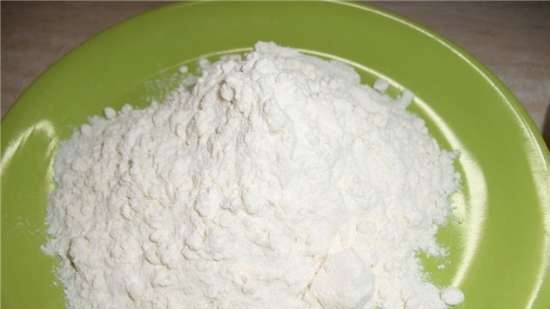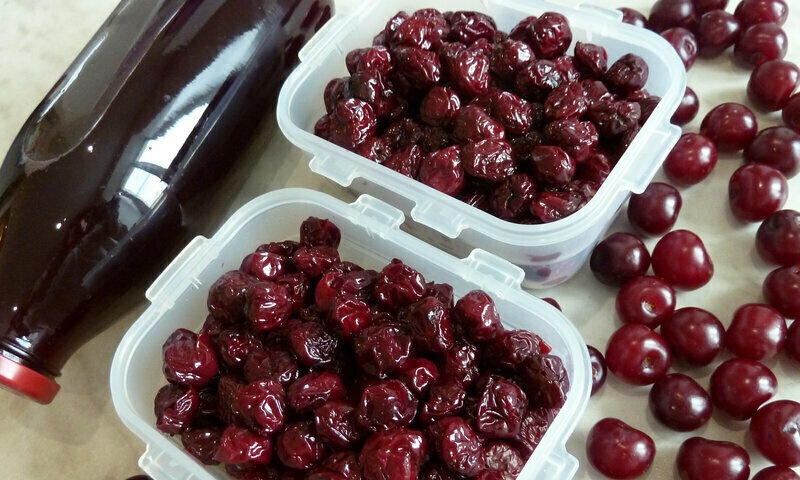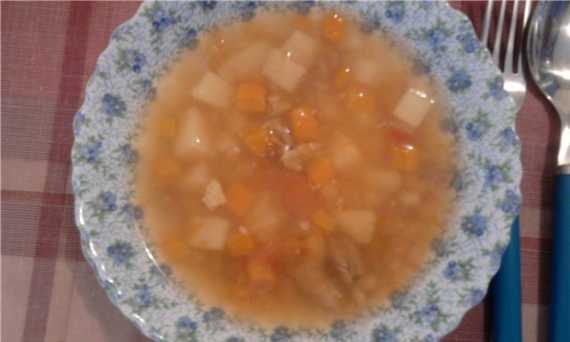Topic 3. Tools and devices necessary for baking homemade bread.
In order to correctly measure the products (ingredients) for kneading dough and baking homemade bread in a bread machine, we need the following tools and accessories. Some of them are included with the bread maker (measuring cup, measuring spoon, kneading knife), others need to be purchased by yourself, since they give accuracy in measurements and are simply necessary in working with the dough.
We look at the photo.
Now I will comment on each item in the photo.
1. Tools for the Hitachi bread maker are shown on the left:
- 240 ml measuring cup.
- measuring spoon at 2 ends - 15 ml tablespoon / 5 ml teaspoon.
- a silicone spatula for raking flour and dough from the sides of the bucket during kneading (not included in the package).
2. The photo in the center shows:
- electronic scales for weighing products (ingredients)
- sieve (battery operated) for sifting flour
- scoop-shovel for bulk products, for the convenience of applying from a bag to a sieve or bucket.
- tools for the Panasonic SD-255 bread maker: 310 ml measuring cup, kneading knives for wheat and rye dough, measuring spoon at 2 ends - 15 ml table spoon. and a teahouse for 5 ml.
3. Shown on the right are other necessary accessories that can be purchased freely at hardware stores.
- measuring cups (plastic and glass) with graduations.
- measuring spoons in a set from 5 to 15 ml.
- measuring spoon at 2 ends - 15 ml tablespoon, 5 ml teaspoon.
All proportions and quantities of products (ingredients) in recipes from Instructions for bread makers, on the Bread Maker forum, ru, or on other sites are indicated by the authors in these very meters - measuring cups (glasses), measuring tablespoons and teaspoons.
Or they are indicated in grams, then the products just need to be weighed in the amount you need on the scales.
The volume of the measuring cups is different from one manufacturer to another.
Measuring tablespoons and teaspoons - all bread makers have the same volume - 15 and 5 ml. respectively.You can read about what other tools and devices you can use in home baking in the topic:
Baking tools and accessoriesTopic 4. INFORMATION ABOUT PRODUCTS (INGREDIENTS)
Products used in baking are measured in different sizes: tablespoons and teaspoons, cups, glasses, on the tip of a knife, pieces, pieces, etc.
To do this, a measuring table, a measuring teaspoon (two spoons on one handle) and a measuring cup (cup) are attached to the bread maker. If the measuring spoons are the same for all ovens, then the measuring cups (cups) are different in volume - pay attention to this when the recipe is given in measuring cups.
What if the measuring cup has a volume of 300 ml. (or other than 240 ml), and you need to take 150 grams of flour?
To do this, on your cup (glass) you need to find a mark, a division of 240-250 ml., And pour wheat or rye flour to this mark, shake it slightly - this will be about 150 grams of wheat flour, or 130 grams of rye flour.
REMEMBER:
1.the yeast is free-flowing, salt is measured only in teaspoons, and in grams
2. Granulated sugar is measured only in tablespoons, and in grams.
3. flour is measured only in measuring cups, and in grams.
4. liquid (water, juice, and other liquids) are measured only in measuring cups and in milliliters.
Never confuse units of measurement - milliliters and grams are different units.
Milliliters are the volume of liquid foods.
Grams are the weight of liquid, solid and other foods The quality of the bread you bake will also depend on how you swap and put these units of measurement in practice. Carefully read the proposed bread recipe and measure the amount of food correctly.
To measure bulk, liquid products (ingredients) in the text, we will introduce the concept of "under the knife". This means that the products indicated in the bread recipe (other pastries), measured with a measuring spoon (tablespoon, teaspoon), or a measuring glass (cup), should be cut off from above with a knife along the edge of the measuring dishes after pouring into the measuring dish.
Thus, the products are measured "without a slide" from above, but only what is included in the measuring dishes. If this is not done, then the weight of the products indicated in the recipes will differ from the actually measured in a larger direction, which will entail a discrepancy and correction of the weight of the products.Pay attention to the measurement accuracy of water, oil, liquid honey, juices and other liquid products. When they are measured with measuring dishes, a "slide" is also possible, which must be cut off with a knife.
REMEMBER:Number of main ingredients (products) in one measuring cup (240 ml) and one measuring spoon. The number is approximate. All products are measured "under the knife"
Simple clean water - 1 measuring cup equals 240 ml.
Simple pure water - 1 measuring tablespoon equals 15 ml
Wheat flour - 1 measuring cup equals 150 grams
Wheat flour - 1 measuring tablespoon equals 9 grams
Rye flour - 1 measuring cup equals 130 grams
Rye flour - 1 scoop equals 9 grams
Salt - 1 scoop equals - fine salt 8 grams, coarse salt 7 grams
White granulated sugar - 1 tablespoon equals 15 grams
Bulk yeast - 1 scoop equals 4 grams
Fresh pressed yeast (wet) at the rate of 2 grams per 100 grams of flour.
Vegetable oil - 1 measuring tablespoon equals 15 ml. or 15 grams.
WHEAT FLOUR. Flour is used for baking wheat white baking bread (this should be written on the bag with flour when buying it). Flour should be well dried, as raw flour contains more moisture, which can affect the dough when kneading.
The flour must be measured with a measuring cup that comes with the oven. Pour the required amount of flour into the cup, but do not tamp it, but simply compact it slightly, tapping the cup on the table, and cut off the excess with a knife (called "under the knife").
We measure (weigh) the flour into a separate bowl and then
be sure to sift through a sieve, to remove various impurities "byaki", and saturate the flour with oxygen, it is very useful for her, which will positively affect the quality of the finished bread.
Why you need to sift flour.
Here is a photo
flour not sifted - lumps and flour caking are visible. Such flour may contain various flour pests and just garbage.

This photo shows already
sifted flour - it looks lighter and more airy and there is a certainty that nothing but the flour itself is present here.
 REMEMBER:
REMEMBER:
1.If you are using measuring cups, first measure out the required amount of the flour before sifting.
2. If using a scale, first weigh the required amount of flour, and only then sift it.
The volume of sifted and wholemeal flour will be different, which will not coincide in the end with the amount of flour indicated in the recipe.
In order to predict in advance the result of the finished bread, and to know what can happen when you put different types of flour in the dough, you need to familiarize yourself with their characteristics and properties
Classification and grade of Russian and imported flour, their interchangeabilityWATER Water is measured with a measuring cup in milliliters. Try to measure it correctly as the presence of water (or liquid) in the batch is very important.
Another important point is if the room temp. air up to 27 degrees. it is necessary to take water at room temperature, over 27 * - water from the refrigerator - 5 *.
The water must also be clean, I use tap water, but filtered.
Water quality also plays a role in bread baking, bread height, duty cycle, crumb quality.
Hard water is better for baking bread. Soft water contains various salts, especially magnesium, which soften the flour and the dough can "float", become softer, more than required.
Never strive for the accuracy of measuring water (liquid) to a milliliter, the error is acceptable.
Read about the effect of water on bread dough here:
Water as a component of the doughAbsorption of liquid by various types of flour, cereals, flakesYEAST Any dry active fast-acting yeast is used in bakery, including SAF-moment, SAF-Instant, D "Etker, Fermipan and others.
An indispensable condition - the yeast must be fresh in terms of shelf life and not fake (of which there are many on the market and in stores).
Yeast is measured with a measuring teaspoon in the amount of "under the knife"In this bread recipe, SAF-Moment yeast was used.
You should not use yeast for bread, intended for baking pizza, muffins and other baked goods, you can read about their purpose on the package.
On each package of yeast, the manufacturer indicates how much yeast should be put in 500 (1000) grams of flour, this is also very important for high-quality kneading of bread dough.
Increasing the amount of yeast in the dough (say, twice) will not lead to the same increase in the rate of fermentation - both because of the struggle of the yeast for the available resources (oxygen and sugar), and because the more yeast, the more carbon dioxide it produces, and it slows down their activities.
By doubling the yeast, we won't make the dough come up twice as fast. Moreover, it can impart an undesirable taste to the product.
Bread made from dough with a little yeast tastes more like traditional bread
In order to predict the result of the finished bread in advance, and to know what can happen when you put certain yeasts in the dough, you need to familiarize yourself with their characteristics and properties.
About yeast - discussion, exchange of experienceYeast - types, use, bookmark, selectionSALT We measure the salt with a measuring teaspoon. Salt can be used by any manufacturer, but it should be borne in mind that iodized salt can affect the structure of the dough, it can become "floating", since iodine softens the food.
Do not mix salt directly with yeast (or add it to yeast solution). The relatively high salt concentration neutralizes the yeast.
Salt is added at the very end, when all the ingredients are already in the dough. Then its percentage is small, and it will not hurt the yeast.
You can use coarsely ground gray salt, sea salt, previously pitching it in a blender (mill), so that it disperses faster in the dough and does not damage the walls of the bread maker's bucket.
Coarse salt was used in this bread recipe.
SUGAR
We measure sugar with a measuring tablespoon Sugar is used in different colors, properties, and other characteristics. You can use granulated sugar, white, brown, etc.
Sugar can be replaced with sugar syrup, molasses, honey, fructose, cane sugar, lump sugar, etc. in the same amount as regular sugar.
Too high sugar content also interferes with the activity of yeast.
Some housewives ask why, when they put sugar in the yeast dough, the pies are unsweetened. This means that all the sugar the yeast has "eaten". Therefore, it is very important to accurately observe the ratio of all ingredients.
Yeast will not play without sugar, but if there is an excess of it, the dough will not work. Using live (pressed) yeast slows down the process and results in a more balanced flavor.
This bread recipe uses plain white granulated sugar.
OIL The vegetable oil is measured out with a measuring tablespoon.This bread recipe uses olive oil.
It should be noted that bread dough loves butter, so do not be afraid to add an extra spoonful of vegetable oil to the dough when kneading.
But with butter, you need to be careful, put in the bread dough as much as required by the recipe. The more butter, the heavier the dough becomes.
You can combine butter with vegetable oil.
In order to predict the result of the finished bread in advance, and to know what can happen when you put certain types of butter in the dough, you need to familiarize yourself with their characteristics and properties.
The use of fats in baking All ingredients used in home baking can be found in the section
Bread Baking Ingredients & Accessories 




